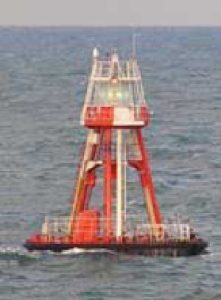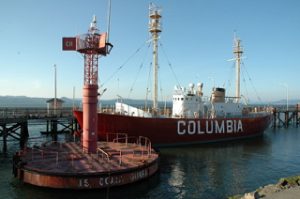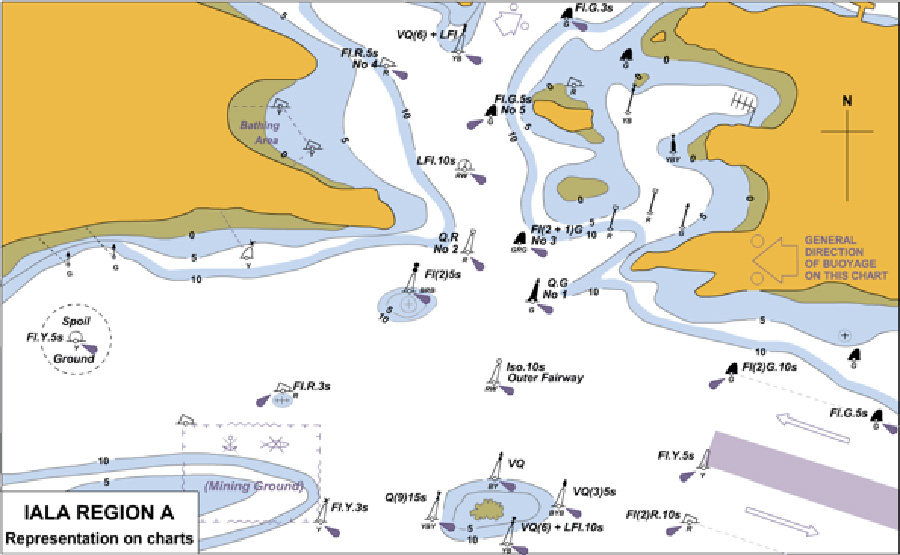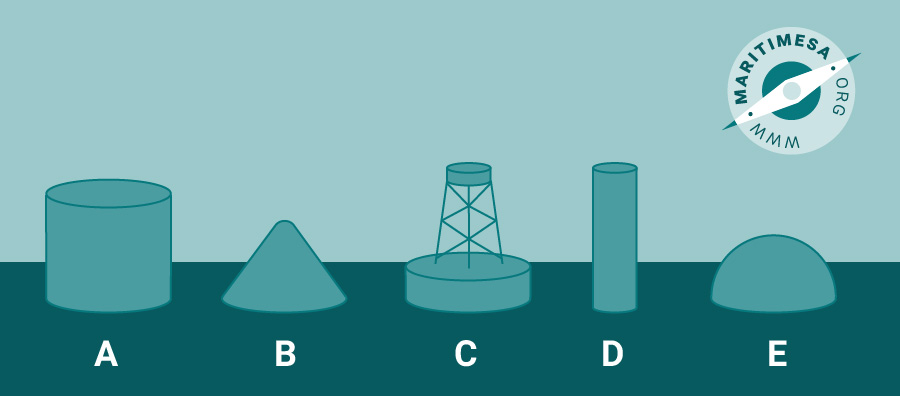Application and purpose.
The system applies to all fixed and floating marks, other than lighthouses, sectors of lights, leading lights and marks, lanbys, certain large light floats and light vessels.

Lanby (Large automated navigation buoy).

Lanby with lightship in the background.
Its purpose is to indicate:
- The sides and centrelines of navigable channels;
- Navigable channels under fixed bridges;
- Natural dangers and other obstructions such as wrecks;
- Areas in which navigation may be subject to regulation;
- Other features of importance to the mariner.
Chart symbols and abbreviations.
All local and international maritime charts incorporate the new symbols and abbreviations indicating the positioning and identification of buoys. The nature, characteristics and marking of the buoys are contained in Chart 5011 – Symbols and abbreviations used on Admiralty Charts and in SAN HO-6 (INT 1) – Symbols and Abbreviations used on South African Charts.
Marks.
The system provides for five types of mark:
- Lateral;
- Cardinal;
- Isolated danger;
- Safe water; and
- Special.
Wrecks are marked in the same way as other dangers, there is no unique mark reserved for them.
Colours.
The following colours are reserved for the marks indicated:
- Lateral – red and green.
- Special marks – Yellow.
- Isolated danger – red and black.
- Safe water – red and white.
- Cardinal – yellow and black.
On Admiralty and South African charts the following conventions apply. Where a buoy symbol has been coloured in, ie black symbol, it indicates the colour green. The colour(s) of the buoy are marked with letters of the alphabet next to the symbol, ie horizontal stripes in the sequence yellow, black, yellow would be given as BYB next to the symbol.

IALA Region A
Shapes.
Five basic shapes were defined when the system was devised:
- Can – (A).
- Conical – (B).
- Pillar – (C).
- Spar – (D).
- Spherical – (E).
Marks that do not rely on their shape for identification, carry the appropriate topmark whenever practicable. On Admiralty charts, if the shape of the buoy is not known, a pillar buoy is used.

Buoy shapes.
Topmarks.
There are only four different topmarks:
- Can.
- Conical.
- Spherical.
- X-shaped.
On pillar and spar buoys the use of topmarks is particularly important. On Admiralty charts topmarks are shown boldly in solid black except where the topmark is red, when it is in outline only.
Lights.
Red and green lights are reserved for lateral marks and yellow for special marks. White lights are used for the other marks and are distinguishable from one another by their rhythm.
Retroreflectors.
Two codes are used with retroreflectors, the Standard code and the Comprehensive code.
The Standard code uses the following markings:
- Red lateral marks – One red band or red shape similar to the top mark.
- Green lateral marks – One green band or green shape similar to topmark.
- Preferred channel marks – As for red or green Lateral marks, depending on the dominant colour.
- Special marks – One yellow band, yellow X, or yellow symbol.
- Cardinal, Isolated – One or more white bands, letters, numerals or symbols.
- Danger & safe water marks.
Radar reflectors.
Whilst it is not shown on the chart, most major buoys are fitted with radar reflectors.

Radar reflector.

